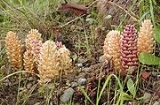
Boschniakia hookeri
Encyclopedia
Boschniakia hookeri is a species of parasitic plant
in the broomrape family
known by the common names Vancouver groundcone and small groundcone.
It is native to western North America from British Columbia
to northern California
, where it grows in wooded areas. It is a parasite of salal
bushes, which it parasitizes by penetrating them with haustoria
to tap nutrients. The groundcone is visible aboveground as a purplish, brown, or yellowish cone-shaped inflorescence
3 to 6 centimeters long. Pale-colored flowers emerge from between the overlapping bract
s. Coastal aboriginal groups ate the potato-like stembase of Ground Cones raw, though usually as a snack and not in any quantity http://www.northernbushcraft.com/plants/groundCone/notes.htm.
Parasitic plant
A parasitic plant is one that derives some or all of its sustenance from another plant. About 4,100 species in approximately 19 families of flowering plants are known. Parasitic plants have a modified root, the haustorium, that penetrates the host plant and connects to the xylem, phloem, or...
in the broomrape family
Orobanchaceae
Orobanchaceae, the broomrape family, is a family of flowering plants of the order Lamiales, with about 90 genera and more than 2000 species. Many of these genera were formerly included in the family Scrophulariaceae sensu lato...
known by the common names Vancouver groundcone and small groundcone.
It is native to western North America from British Columbia
British Columbia
British Columbia is the westernmost of Canada's provinces and is known for its natural beauty, as reflected in its Latin motto, Splendor sine occasu . Its name was chosen by Queen Victoria in 1858...
to northern California
California
California is a state located on the West Coast of the United States. It is by far the most populous U.S. state, and the third-largest by land area...
, where it grows in wooded areas. It is a parasite of salal
Salal
Gaultheria shallon is a leathery-leaved shrub in the heather family , native to western North America. In English it is known as salal, shallon, or in Britain simply Gaultheria.-Ecology:...
bushes, which it parasitizes by penetrating them with haustoria
Haustorium
In botany, a haustorium is the appendage or portion of a parasitic fungus or of the root of a parasitic plant that penetrates the host's tissue and draws nutrients from it. Haustoria do not penetrate the host's cell membranes.Fungi in all major divisions form haustoria...
to tap nutrients. The groundcone is visible aboveground as a purplish, brown, or yellowish cone-shaped inflorescence
Inflorescence
An inflorescence is a group or cluster of flowers arranged on a stem that is composed of a main branch or a complicated arrangement of branches. Strictly, it is the part of the shoot of seed plants where flowers are formed and which is accordingly modified...
3 to 6 centimeters long. Pale-colored flowers emerge from between the overlapping bract
Bract
In botany, a bract is a modified or specialized leaf, especially one associated with a reproductive structure such as a flower, inflorescence axis, or cone scale. Bracts are often different from foliage leaves. They may be smaller, larger, or of a different color, shape, or texture...
s. Coastal aboriginal groups ate the potato-like stembase of Ground Cones raw, though usually as a snack and not in any quantity http://www.northernbushcraft.com/plants/groundCone/notes.htm.

